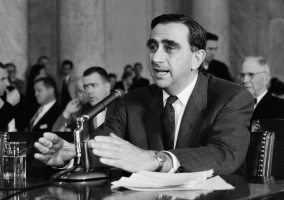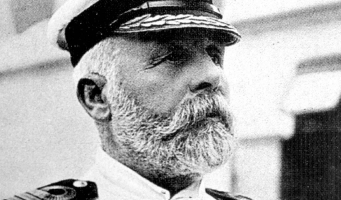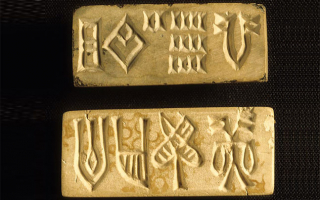Top 7 Interesting Facts about Edward the Confessor
One of the last Saxon rulers of England, Edward the Confessor reigned from 1042 to 1066, and his reign was followed by a period of unrest in English history. ... read more...He is renowned for his faith as well, which contributed to his canonization. Ultimately, the Norman invasion of England in 1066 was brought on by his failure to leave a legitimate heir to the throne. The following information about King Edward the Confessor is fascinating. Here is the top 7 interesting facts about Edward the Confessor.
-
King Ethelred the Unready and Queen Emma, a descendant of the Duke of Normandy, were the parents of Edward. The family fled to Normandy when the Danes conquered England in 1013, where Edward spent 25 years. An interesting detail about Edward the Confessor is that many of his closest advisors when he became king were Normans.
Between 1016 and 1040, when Edward was exiled in Normandy, little is known about his lengthy absence. But in light of new studies, it is worthwhile to review the sparse evidence once more, in particular: the examination of the four Norman charters that mention Edward during this time, the most current book on the creation of early Normandy, the research on Norman abbots, and the study of English queens from the eleventh century.
In 1066 Edward the Confessor died childless leaving no direct heir. He had strong connections to Normandy where Duke William had ambitions for the English throne. In England, Edward had had a longstanding rivalry with the powerful Earl Godwin.

Source: Fine Art America 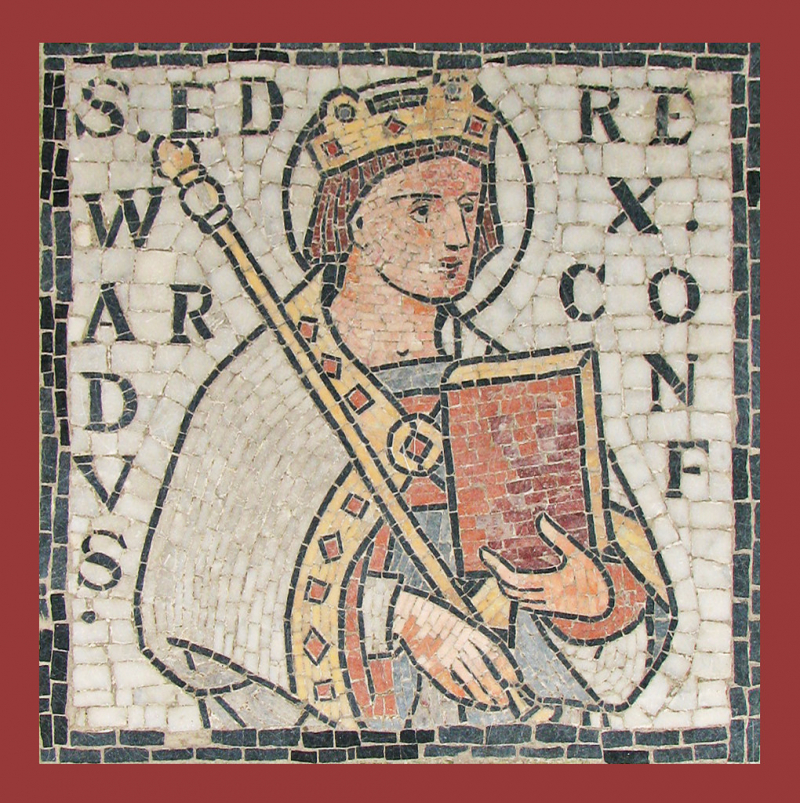
Source: Flickr -
The three most powerful Earls in England at the time—Leofric of Mercia, Siward of Northumbria, and Godwin of Wessex—held the real authority during Edward's reign as king. These three and the other Earls were not fond of Edward because he favored his Norman counselors. Alexander III, the pope, canonized Edward the Confessor, who went by this moniker because of his great religiosity, in 1161. He was one of England's final Anglo-Saxon kings, ruling from 1042 to 1066, an impressive twenty-four years.
The son of King Ethelred "the Unready" and his wife Emma of Normandy, the final monarch of the House of Wessex was born in Oxfordshire at Islip. He was the first child of Ethelred's new wife, Emma, and the eighth son of the king. His early years were ruined by the ongoing conflict caused by Viking assaults that attacked England. He was born around 1003. Emma of Normandy and her sons, Edward and Alfred, were forced to flee to safety in 1013 after Sweyn Forkbeard usurped the kingdom.
His family had been expelled by Danish control, thus he spent a large portion of his early years living in exile in France. After his father Ethelred died in 1016, Edward's half-brother Edmund Ironside was left in charge of defending England from Danish attack while also having to deal with the formidable threat posed by Sweyn's son Cnut.

Source: The Times 
Source: iStock -
Earl Godwin of Wessex had become one of the most powerful Earls in England during the reign of Edward’s predecessor, the Danish king Cnut the Great. His daughter Edith of Wessex married Edward the Confessor in 1045. When Cnut died in 1035, his lands were divided among three contenders, Alfred Aetherling being one of them (and also the brother of Edward).
With Earl Godwin's backing, he usurped the throne from Harold Harefoot, who had assumed it. Edward believed Godwin was responsible for Alfred's blindness and death since it was said that Godwin either kidnapped Alfred or tricked him into thinking he was an ally before giving him to Harold. Despite the absurd fact that Edward the Confessor married Godwin's daughter, this resulted in a rivalry that was never forgotten.

Source: todayinbritishhistory.com 
Source: pinterest.co.uk -
Although Edward had no power to make any promises because the English monarchy was not hereditary, it appears that he did so anyway, which led to a succession issue after his death. He most likely saw Harold Godwinson as his successor, and the two men worked out a deal for Harold to succeed Edward as king. He was killed at the Battle of Hastings in the same year, though, so he didn't live long (1066). Harold was the child of Earl Godwin of Wessex, who had essentially seized power even while Edward was still alive.
According to a medieval legend, Edward had made the decision to remain celibate before getting married and, given his support for the Normans, would have always wanted William the Conqueror to replace him. It is said that during a time when Godwin was banished after having a disagreement with Edward, Edward would have offered William the succession. The Normans asserted that in order to ensure William's succession, Edward dispatched Harold Godwinson to Normandy in 1064. In the end, this paved the way for William the Conqueror to invade at the Battle of Hastings. Harold is thought to have received the throne from Edward the Confessor as he lay dying, but William later asserted that his pledge would take precedence.

Source: myinterestingfacts.com 
Source: mercedesrochelle.com -
Edward the Confessor is notable for having commissioned the construction of Westminster Abbey, one of London's most recognizable structures today. St. Edward the Confessor, the penultimate Saxon king of England, started construction on Westminster Abbey, which is situated close to the existing Houses of Parliament, not long after his coronation in 1042. In order to supervise the building of his new Abbey, he also constructed a palace close by.
It was begun in 1042 as a royal burial church and is the first Norman Romanesque structure in England. After Edward died in 1090, the church was completed, but it was destroyed in 1245 to make room for King Henry III's new structure, which is the one we can still see today. Even though Edward wasn’t particularly interested in the arts, the building of Westminster Abbey helped develop English Romanesque architecture and made him into an important patron of the church.

Source: hammeredbritishcoins.com 
Source: rareoldprints.com -
Up until 1348, Edward the Confessor was considered as the national saint of England together with Edmund the Martyr and Gregory the Great. King Edward III, however, favoured Saint George at this time since he was a more aggressive warrior, and he named St. George the patron saint of the Order of the Garter. Early misfortune so taught Edward the foolishness of ambition, and he grew up innocently, enjoying mostly helping at Mass and the church offices, and being among religious, although not disliking the pleasures of the chase, or recreations appropriate to his station.
Harold, Canute's illegitimate son who was living in Denmark at the time of his father's death in 1035, ascended to the crown. He did not engage in any conflicts other from helping Malcom III of Scotland fight Macbeth, the man who had usurped his kingdom, and repelling a Welsh invasion. Edward had no personal ambitions; his only concern was for the wellbeing of his people. Although he was generous with alms to the needy and for religious reasons, he managed to make his own royal patrimony sufficient without levying taxes. He also abolished the abhorrent "Danegelt," which had been needlessly continued to be charged. Because "the wonderful St. Edward's laws" brought them such contentment, following generations constantly called for their implementation whenever they felt oppressed.
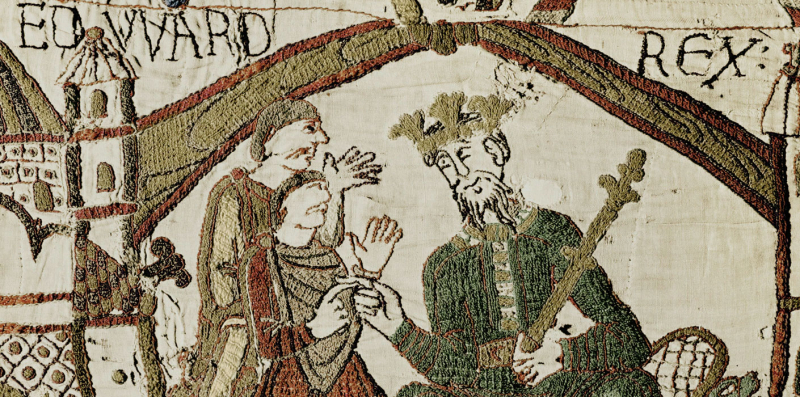
Source: The Royal Family 
Source: aidanharticons.com -
The details of his death bed are interesting. The tapestry shows a weak Edward on his deathbed surrounded by four people. They are unnamed on the tapestry, but the female figure is most likely Queen Edith and one will have to be Harold. Queen Edith writes about what occurred at the deathbed of King Edward in the Life of King Edward book that she commissioned. This confirms the people who were there and appear on the tapestry (Harold, Edith, Archbishop Stigand, and Rodbert a steward).
At this time King Edward tells those present of a dream he had about two monks he had known bringing him a warning from God. They told him “within a year and day of Edward’s death…God would punish the whole of England by delivering it into the ‘hands of the enemy’ and that ‘devils shall come through all this land with fire and sword and the havoc of war…” Bridgeford notes that since this was written after the events of the Conquest the author already knew how history would play out, but this was how the Conquest appeared to the people of England. They did not want William and they were the devils who invaded their land. But, the most important part of the deathbed is who Edward names for his successor.

Source: patriciabracewell.com 
Source: flickr.com









